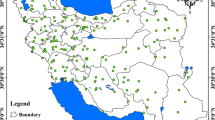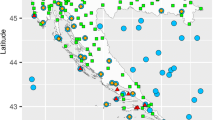Abstract
The present study made use of daily and monthly sunshine duration hours per day data from Islamic Republic of Iran Meteorological Organization from 1974 to 2005. Various methods have used geostatistical interpolation. With the cross-validation method and analysis of validation criteria, the empirical Bayesian kriging with is future to have better performance for the temporal–spatial distribution. The results indicate there is enough sunshine duration, i.e., 5 h per day during the cold period of the year, and in the warm period, the figure increases to more than 10 h. While sunshine duration has an upward trend, cloudiness shows a downward trend in Iran. The spatial distribution of sunshine duration is strongly influenced by local conditions. On the coast of the Caspian Sea, which has a high latitude and the longest days, the least sunshine duration occurs in all seasons. Even in south coast, which has a lower latitude, a reduction in the sunshine duration hours takes place in warm months because of the cloudiness along the coastal regions. Desert regions with the arid climatic in the center, south and east of Iran enjoy the maximum sunshine duration hours. In the western half of the country due to unevenness density, the number of sunshine hours is less than the eastern half. Eastern, central and southeastern regions in Iran have the most optimal sunshine duration. In general, the sunshine duration increases from north to south.






Similar content being viewed by others
References
Aksoy B (1999) Analysis of changes in sunshine duration data for Ankara, Turkey. Theor Appl Climatol 64(3–4):229–237
Alijani B, O’brien J, Yarnal B (2008) Spatial analysis of precipitation intensity and concentration in Iran. Theor Appl Climatol 94(1–2):107–124
Apaydin H, Anli AS, Ozturk F (2011) Evaluation of topographical and geographical effects on some climatic parameters in the Central Anatolia Region of Turkey. Int J Climatol 31(9):1264–1279
Bhunia GS, Shit PK, Maiti R (2016) Comparison of GIS-based interpolation methods for spatial distribution of soil organic carbon (SOC). J Saudi Soc Agric Sci. doi:10.1016/j.jssas.2016.02.001
Dobesch H (1992) On the variations of sunshine duration in Austria. Theor Appl Climatol 46(1):33–38
Ertekin C, Evrendilek F (2007) Spatio-temporal modeling of global solar radiation dynamics as a function of sunshine duration for Turkey. Agric For Meteorol 145:36–47
ESRI (2001) ArcGIS geostatistical analyst: statistical tools for data exploration, modeling, and advanced surface generation. pp 1–19. An ESRI white paper. Redlands, CA
Founda D, Kalimeris A, Pierros F (2014) Multi annual variability and climatic signal analysis of sunshine duration at a large urban area of Mediterranean (Athens). Urban Clim 10:815–830
Gil V, Gaertner MA, Sanchez E, Gallardo C, Hagel E, Tejeda C, de Castro M (2015) Analysis of interannual variability of sunshine hours and precipitation over Peninsular Spain. Renew Energy 83:680–689
Hasanipak EA (2011) Geostatistics. The University of Tehran Publisher, Tehran
Isaaks EH, Srivastava RM (1989) An introduction to applied geostatistics. The Oxford University Press, Oxford
Jarraud M (2008) Guide to meteorological instruments and methods of observation (WMO-No. 8). World Meteorological Organisation, Geneva
Johnston K, VerHoef JM, Krivoruchko K, Lucas N (2001) Using Arc-GIS. Geostatistical analyst. ESRI, 300 p. California
Krivoruchko K (2004) Introduction to modeling spatial processes using geostatistical analyst. ESRI Educational and Research Papers, Redland. http://www.esri.com/library/whitepapers/pdfs/intro-modeling.pdf
Majani BS (2007) Analysis of external drift kriging algorithm with application to precipitation estimation in complex orography. International Institute for Geo-Information Science and Earth Observation Enschede, Enschede, pp 1–91
Massodian SA (2012) Climatology of Iran. Shariaeh Toos Press, Isfahan
Matzarakis AP, Katsoulis VD (2006) Sunshine duration hours over the Greek region. Theor Appl Climatol 83(1–4):107–120
Monger SH, Monger ER, Dyreson AR, Acker TL (2016) Applying the kriging method to predicting irradiance variability at a potential PV power plant. Renew Energy 86:602–610
Park JK, Das A, Park JH (2015) Anew approach to estimate the apatial distribution of solar radiation using topographic factor and sunshine duration in South Korea. Energy Convers Manag 101:30–39
Philip GM, Watson DF (1982) A precise method for determining contoured surfaces. Aust Petrol Explor Assoc J 22(1):205–212
Power HC, Mills DM (2005) Solar radiation climate change over Southern Africa and an assessment of the radiative impact of volcanic eruptions. Int J Climatol 25(3):295–318
Price DT, McKenney DW, Nalder IA, Hutchinson MF, Kesteven JL (2000) A comparison of two statistical methods for spatial interpolation of Canadian monthly mean climate data. Agric For Meteorol 101(2):81–94
Rehman S, Ghori SG (2000) Spatial estimation of global solar radiation using geostatistics. Renew Energy 21(3):583–605
Sanchez-Lorenzo A, Calbó J, Martin-Vide J (2008) Spatial and temporal trends in sunshine duration over Western Europe (1938–2004). J Clim 21(22):6089–6098
Weber GR (1990) Spatial and temporal variation of sunshine in the Federal Republic of Germany. Theor Appl Climatol 41(1–2):1–9
Wibig J (2008) Cloudiness variations in Łódź in the second half of the 20th century. Int J Climatol 28(4):479–491
Wu W, Tang XP, Yang C, Gue NJ, Liu HB (2013) Spatial estimation of monthly mean daily sunshine hours and solar radiation across mainland China. Renew Energy 57:546–553
Acknowledgements
The researchers of the study therefore express their gratitude and appreciation to the Islamic Republic of Iran Meteorological Organization (IRIMO) for providing the data of the meteorological stations in this study.
Author information
Authors and Affiliations
Corresponding author
Additional information
Editorial responsibility: Mohamed Fathy Yassin.
Rights and permissions
About this article
Cite this article
Ahmadi, H., Ahmadi, F. Evaluation of sunshine duration and temporal–spatial distribution based on geostatistical methods in Iran. Int. J. Environ. Sci. Technol. 16, 1589–1602 (2019). https://doi.org/10.1007/s13762-017-1608-4
Received:
Revised:
Accepted:
Published:
Issue Date:
DOI: https://doi.org/10.1007/s13762-017-1608-4




